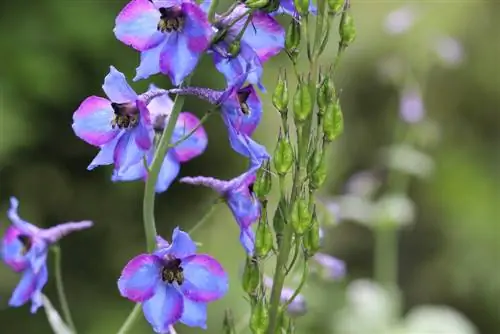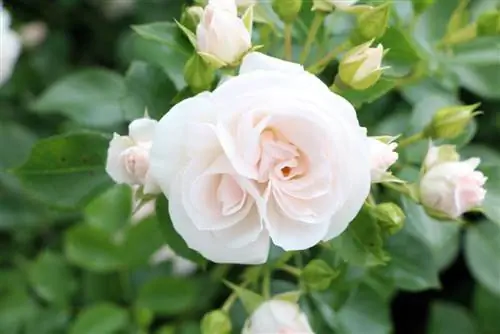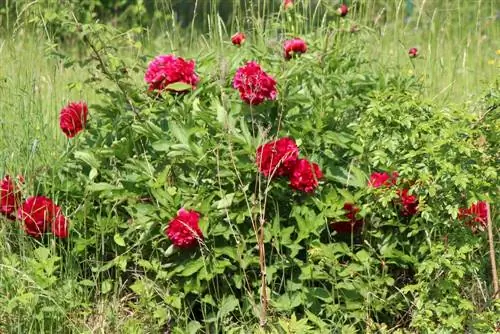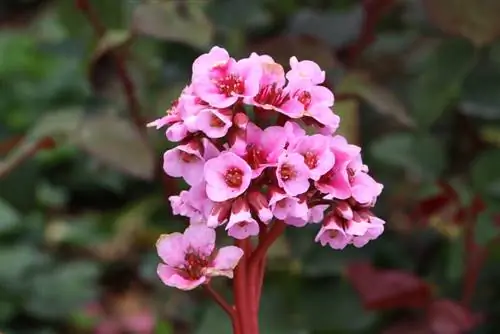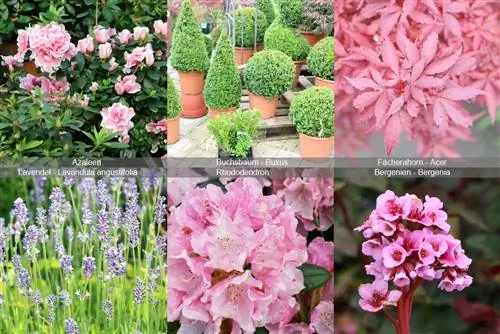- Author admin [email protected].
- Public 2023-12-17 03:39.
- Last modified 2025-01-24 12:45.
For ambitious hobby gardeners, cutting and dividing their perennials are among the most complex jobs in their garden. However, if they are carried out correctly, the hobby gardener will be rewarded with a colorful sea of flowers in the garden. By following just a few rules, you can extend the lifespan of plants through targeted and sensible cutting and division measures. Cutting also improves flowering and dividing creates new plants that decorate the garden in a different place.
removal cut
The expert speaks of remontant pruning when the plant is radically cut back after flowering. Pruning is done immediately after flowering to a height of 5 to a maximum of 10 cm above the ground. However, not all perennial plants tolerate pruning. Below is a small selection of plants that tolerate pruning well:
- Lady's Mantle (Alchemilla epipsila)
- Mountain knapweed (Centaurea montana)
- Gold basket (Chrysogonum virginianum)
- Delphinium (Delphinium)
- Lavender (Lavandula angustif.)
- Meadow knotweed (Polygonum bistorta)
- Horn violet (Viola cornuta)
After-flowering pruning
When pruning after flowering, the perennial is cut back just as radically after flowering. As a rule, the cut is made a hand's width above the ground. However, in contrast to remounting pruning, no new blooms are to be expected with post-flowering pruning. Nevertheless, post-flowering pruning has some advantages. On the one hand, he althy new growth is promoted, thereby increasing the lifespan of the plant. On the other hand, hobby gardeners maintain the authenticity of the variety by cutting after flowering and prevent self-sowing. Ultimately, the shape of the pruning prevents wilting and fungal infestation. A post-flowering cut can tolerate, among other things:
- Lady's Mantle (Alchemilla mollis)
- Indian Nettle (Monarda)
- Jacob's Ladder (Polemonium caeruleum)
- Joint flower (Physostegia virginiana)
- Coneflower (Rudbekia laciniata)
Early autumn pruning
Early fall pruning takes place around the end of September. To do this, the leaves of the perennial are cut back close to the ground. This pruning causes overwintering buds and rosettes to form. Early autumn pruning makes sense for the following plants:
- Oxtongue (Anchusa azurea)
- Dark chamomile (Anthemis tinctora)
- Girl's eye (Coreopsis grandiflora)
- Cockade flower (Gaillardia)
- Magnificent candle (Gaura lindheimeri)
Pre-flower cutting
The pre-flowering cut is called “pinching” in technical language. This takes place in early summer before the flower buds have formed. To do this, the shoot tips of the perennial are shortened by around ten to 15 cm. The purpose of shortening is to make the plants bushy, branch well and produce more flowers. This cut leaves the perennial plant slightly smaller, but much more stable. In addition, the flowering time can be postponed slightly. Below are some examples of a pre-flowering cut:
- Tall asters (Aster novi-belgii)
- Chrysanthemum (Dendranthema grandiflora)
- Sun Bride (Helenium)
- Phlox, tall phlox (Phlox paniculata)
- High Coneflower (Rudbekia laciniata)
Cutting out the flowers
Pruning out the flowers describes the regular removal of flower stems and flowers that have already faded. Cleaning out promotes flower formation, extends the flowering period and prevents self-seeding. However, only what has faded can be cut away. Examples of some plants where trimming really extends the flowering period:
- Oxtongue (Anchusa azurea)
- Summer aster (Aster frikartii)
- Lark Spur (Corydalis cava)
- Sunflower (Helianthus microcephalus)
- Daylily (Hemerocallis)
Cutting out the seed heads
Among the perennial species, there are many that still have attractive foliage after flowering, but self-sow uncontrollably. So it makes sense to cut out most of the seed heads before the seeds are ripe. This prevents the varieties from splitting and prevents self-seeding. In onion plants, cutting out the seed heads can promote new bulb formation. The following perennial plants are suitable for cutting out:
- Ornamental hogweed (Acanthus longifolius)
- Hornwort (Cerastium tomentosum)
- Steppe Candle (Eremurus robustus)
- Bush mallow (Lavatera thuringiaca)
- Lily (Lilium)
- Pimpinelle (Sanguisorba minor)
Post-winter pruning
In contrast to pre-flowering pruning, for some perennials it makes more sense to only prune in spring. Mainly because in winter they form a visual eye-catcher as a framework in the garden and are therefore better protected from cold frosts. In addition, they provide a hiding place for insects and their seed heads serve as a food source for numerous bird species. The following plants can be cut immediately close to the ground after winter:
- Goat's Beard (Aruncus)
- Calamint (Calamintha)
- Snakehead (Chelone obliquata)
- ragwort (Ligularia)
- Sedum (Sedum telephium)
Dividing perennials correctly
If perennials remain in one location for too long, they can become “obsolete” or “senile”. Often their ability to flower decreases or they no longer grow as quickly and become bald in the middle of the clump. Some types of perennials age by becoming dry and brown on the inside or by tipping outwards due to a lack of stability. Then it's high time to divide the perennials and thus rejuvenate them. This way they become more vital and bloom more happily. Tip: When divided, small offshoots are often found that are no longer used in the garden. Placed in planters, these offshoots will beautify the balcony or terrace next year. Provided they have strong roots and at least one shoot tip.
Optimal timing
First and foremost, the timing depends on the plant. Countless perennials such as peony thrive in the same place for many years. For others, the opportunity to share is good every three to six years. Generally, perennials are divided in spring or fall. A distinction must be made between summer perennials and autumn-flowering plants, which can usually be divided in spring, and spring-flowering plants, which tolerate division well in autumn. Sharing instructions:
- only divide parts from the edge area of the plant
- Carefully dig up the rootstock with root soil with the digging fork
- dividing dense root balls with a sod-breaking ceremony
- Sections should have at least two shoot buds
- pick loose roots into fist-sized pieces with your hands
- Remove the soil from weeds, prepare it with compost or organic fertilizer and replant the plant
- Water the perennial well
When dividing, it is important that any dried and diseased root parts are removed before inserting. Examples of perennials that can be divided after three to five years:
- Columbine (Aquilegia)
- Goddess (Dodecatheon meadia)
- Carpet chamomile (Matricaria caucasica)
- Catnip (Nepeta fassii)
After six to ten years, the following perennials, for example, should be divided:
- Cat's paw (Antennaria dioica)
- Delphinium (Delphinium)
- Splendid charcoal (Liatris spicata)
- Joint flower (Physostegia virginiana)
The following perennials can be divided and transplanted after ten to 15 years:
- Pearl Basket (Anaphalis)
- Ball Thistle (Echinops)
- Suneye (Heliopsis scabra)
- Miscanthus sinensis
Among the countless types of perennials, there are also long-lived perennials that can survive without division, but need to be reduced more often due to their spread. These include, among others:
- Autumn Anemone (Anemone hupehensis)
- Hazelroot (Asarum europaeum)
- Deadnettle (Lamium maculatum)
- Peony (Paeonia)
Frequently asked questions
The foliage of my oriental poppy (Papaver orientalis) no longer looks beautiful. What to do?
The foliage of this oriental beauty often looks unsightly after flowering. If summer moisture is added to this, it will easily start to rot. The only thing that helps here is a total cut back.
Can I easily share Globeflower and Bleeding Heart?
These two types of perennials in particular should grow undisturbed if possible. Therefore, division does not make sense.
Things worth knowing about perennial pruning in brief
Most perennials need to be cut and divided. They are usually divided when they get too big and have spread too much. In addition, some perennials need to be divided regularly to maintain and improve their ability to flower. They are cut for various reasons. You can do a pre-flowering cut, a flowering cut, a post-flowering cut, a rejuvenation cut and a pruning.
Cutting types
- Pre-flowering pruning is a targeted pruning of the shoots before the flowers begin. All shoots are shortened by about half. By pinching off the shoot tips, branching and flowering are encouraged. The perennials remain lower, are more compact and very stable. However, the flowering period is delayed by up to 20 days. The right time for this cut is from the end of June to the beginning of July. Pruning is worthwhile for summer and autumn flowering bedding perennials such as suneye, sunbride, autumn aster and phlox.
- Flower pruning is done to extend the flowering period or to encourage the perennial to bloom a second time. For many perennials, the flowering time can be extended if you regularly cut out the withered flowers. This is how new flowers continually form. This cut is ideal for purple coneflower, cockade flower, perennial sunflower, suneye, summer daisy and gold storm coneflower.
- The cut for a second flower is called a remontant cut. This is a total pruning after the first flowering. The perennial is cut back to a hand's width above the ground. Adding mineral fertilizer and watering sufficiently will encourage new growth. This cut is ideal for garden larkspur, fine aster, summer daisy, garden lupine, summer sage, spiderwort, ladder to heaven and garden troll flower.
- The post-flowering cut is carried out to prevent self-seeding. This preserves the authenticity of the variety. The seedlings of many varieties vary and are often worthless. However, they often displace the mother plant. So you cut off the withered inflorescences before they reach seed maturity. This cut is particularly useful for suneye, phlox, goldenrod and spiderwort.
- The rejuvenation cut ensures more compact growth. Since some perennials quickly become unsightly after flowering, fall apart or become similarly unsightly, they should be cut back completely after flowering. They sprout again after just a few days. The fresh green leaves look much better. The clumps remain compact. The appearance is fundamentally improved, even if there is no second flowering. This cut is useful for comfrey, lungwort, lady's mantle, cranesbill and many geranium species.
Cutting time
- Pruning in autumn or early spring serves to form new shoot buds.
- In winter, perennials that are less stable and easily seeded should be cut back by November at the latest.
- If the perennials are stable and have attractive fruit heads, they can be left standing over the winter.
When perennials in the middle of the clump become bare, their growth decreases and there is no abundance of flowers, it is time to divide them and thus rejuvenate them. You dig up the clumps and divide them into small pieces. These can be used again, if possible not in the same place. Only strong and vigorous cuts are used. The growing parts are located on the edge of the nest. The sections should have at least two to three buds.
- The best time for division is during the dormant period between autumn and early spring.
- Grasses are generally divided in spring. Peonies are only divided in autumn.


